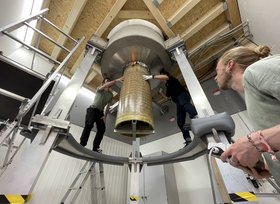University instead of hospital: MRI for more sustainability
Unique new research device inaugurated at the TU Hamburg
17.01.2024

MRI (magnetic resonance imaging) devices are used in medicine to examine the human brain, spinal cord and other internal organs. At Hamburg University of Technology, such a device is now being used for the first time in vertical form for engineering research - and is intended to help develop more sustainable processes in chemical and bioengineering. Prof. Alexander Penn from the Institute for Process Imaging, who officially inaugurated the device today, explains what this looks like in further detail.
Mr. Penn, the term "MRI" probably makes most people think of hospitals and doctors in white coats - what is an MRI doing at a technical university?
A good question! MRIs can not only look into human bodies, but also into other objects and systems. And that's what makes them so exciting for engineering science.
What exactly does that look like?
In chemical and bioengineering, reactors are used to convert certain substances into others. Until now, these reactors have often functioned like a black box: A few things go in - oil, for example - and a product comes out at the end - e.g. gasoline or plastic. But until now it has not been possible to understand exactly how temperatures or gas bubbles are distributed in the reactor, or what the mixing processes inside look like. If we can now look inside with the help of MRI, we will be able to design reactors much better and more efficiently in future.
What advantages does this offer?
In order to live more sustainably and conserve resources, we need to rethink and redesign many of the processes we currently use, moving away from linear production - material in, product out - towards a circular economy in which waste is turned back into raw materials. To achieve this, it is no longer enough to say that we have a black box that we can't look into. We need detailed knowledge quickly and must optimize existing reactor types and processes and design new ones. This is where we want to start with our new MRT in order to provide information and overcome this challenge.
How was the device built and what is so special about it?
MRI machines in hospitals are designed horizontally, which is where the patients lie. Processes in reactors in chemical and bioengineering require gravity, but until now there have been no corresponding vertical MRIs. Together with Tesla Engineering Ltd and Philips Healthcare, we spent three years developing and building this new device, which is unique in this form and is now available to the TU Hamburg for research and teaching.
What projects will be researched at TU Hamburg in the future using this MRI device?
For example, we are participating in the new Collaborative Research Center 1615 "SMART Reactors" of the German Research Foundation (DFG), in which we want to turn the reactors of the future into reality at the TU Hamburg. In this project, we are working together with many partner institutes at TU Hamburg and other universities and developing important measurement technology. In another DFG-funded collaboration project with Prof. Stefan Heinrich at TU Hamburg, we are researching how mechanical vibrations affect the flow behavior of fluidized bed reactors. And we are also planning a collaboration with the Institute for Systems Process Engineering at the TU Hamburg, in which we want to make absorption processes visible. These are very energy-intensive and even small improvements would help to significantly reduce energy consumption in the chemical industry.
See also: https://www.ipi.tuhh.de/3t-vertical-mri-system/
TUHH - Public Relations Office
Kaja Weber
E-Mail: kaja.weber@tuhh.de







